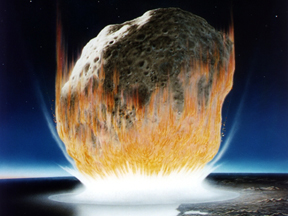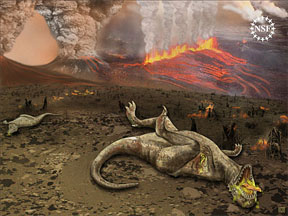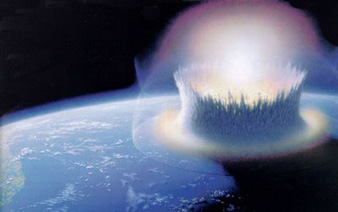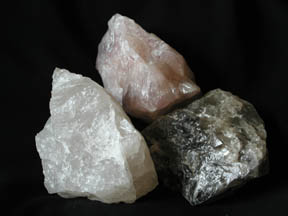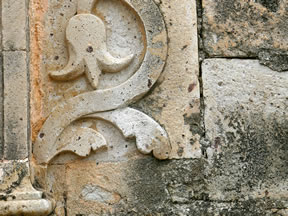Click on image for full size
Courtesy of Don Davis, NASA
Revisiting Chicxulub
News story originally written on March 4, 2010
For decades, scientists have accumulated ever-larger datasets that suggest an enormous space rock crashed into the ocean off the Yucatan Peninsula more than 65 million years ago, resulting in the Cretaceous-Paleogene (K-Pg) extinction.
Last year, though, a research team suggested that the impact could have occurred 300,000 years prior to the K-Pg extinction, and that another cause--perhaps a second impact, or the long-lasting volcanic activity at the Deccan Traps in what is now India--drove numerous plant and animal species to their end.
Now, a team of 41 scientists from 12 nations has prepared a paper to specifically counter the volcanic and dual-impact alternatives, and provide a comprehensive review of the evidence linking a single impact near what is now Chicxulub, Mexico, to the K-Pg extinction.
One factor that is not in dispute: the end of the Cretaceous 65.5 million years ago was marked by one of the most devastating extinctions ever. The most famous victims were the dinosaurs, but the event also saw the loss of all flying reptiles, most marine reptiles, more than half of land plants and insects, and hosts of other terrestrial and marine organisms--50 to 70 percent of all species on Earth.
As with all mass extinctions, paleontologists have long asked why so many organisms disappeared so quickly. The cause, or causes, would have to influence a large swath of the planet, on land and sea, and would have to reflect observations in the geological record.
One of the key arguments for impact is a well-studied clay layer that appears at K-Pg boundary sites across the globe, usually in association with melt-glass remnants, shocked minerals, and other materials generated by impacts. The authors point out that the layer thickness and the abundance of impact materials both increase as you get closer to the Chicxulub crater.
Within the layer, scientists have found high levels of iridium. This heavy element is not normally found in high concentrations at Earth's surface, but it is highly concentrated in undifferentiated solar system material, like asteroids and comets. Since that initial discovery, further studies by a number of teams uncovered more impact evidence within the clay, including the spherules of altered melt-glass and impact-shocked minerals.
Additional studies, both in the field and in laboratory simulations and models, led to widespread support of the impact hypothesis. As it currently stands, the extinction resulted from the collision of a space rock roughly 10 kilometers in diameter into carbon- and sulfur-rich rocks beneath what is now Chicxulub, Mexico, yielding a crater that is more than 180 kilometers in diameter; regional tsunami, earthquakes and fires; extended (but not total) darkness; cooling temperatures and acid rain.
In some sites close to the impact, around the Gulf of Mexico and the Caribbean, there are two spherule-bearing layers, at times separated by sediment a few meters thick, and some of the recent controversy stems from this apparent duality. The scientists studying these layers say, however, that two layers does not mean there were two impacts; instead, the evidence suggests that there is a single layer that has been disturbed in some places by local seismic activity.
The authors close their paper by discussing the speed and scale with which the impact affected living systems, particularly in relation to the speed and scale of volcanic activity.
An impact the size of the Chicxulub event would release large amounts of water, dust and gasses into the atmosphere, temporarily changing climate. An estimated 100-500 gigatons of sulfur was also released, contributing to devastating acid rains on land and in the oceans, and producing sunlight-absorbing sulfur aerosols that may have further cooled the Earth for several years.
Because deep ocean temperatures were largely unaffected, the researchers suggest that the climate recovered relatively rapidly. Such a brief transition is in contrast to the centuries-long effects that would result from volcanic activity.
Additionally, the boundary between the end of the Cretaceous and the start of the Paleogene is marked by clear changes in the plants and animals that existed, a change that is not gradual. Species across the globe showed either extinction or major changes in abundance. This kind of biological evidence, the scientists assert, matches best to an impact scenario, corroborating the evidence from the geologic record.


